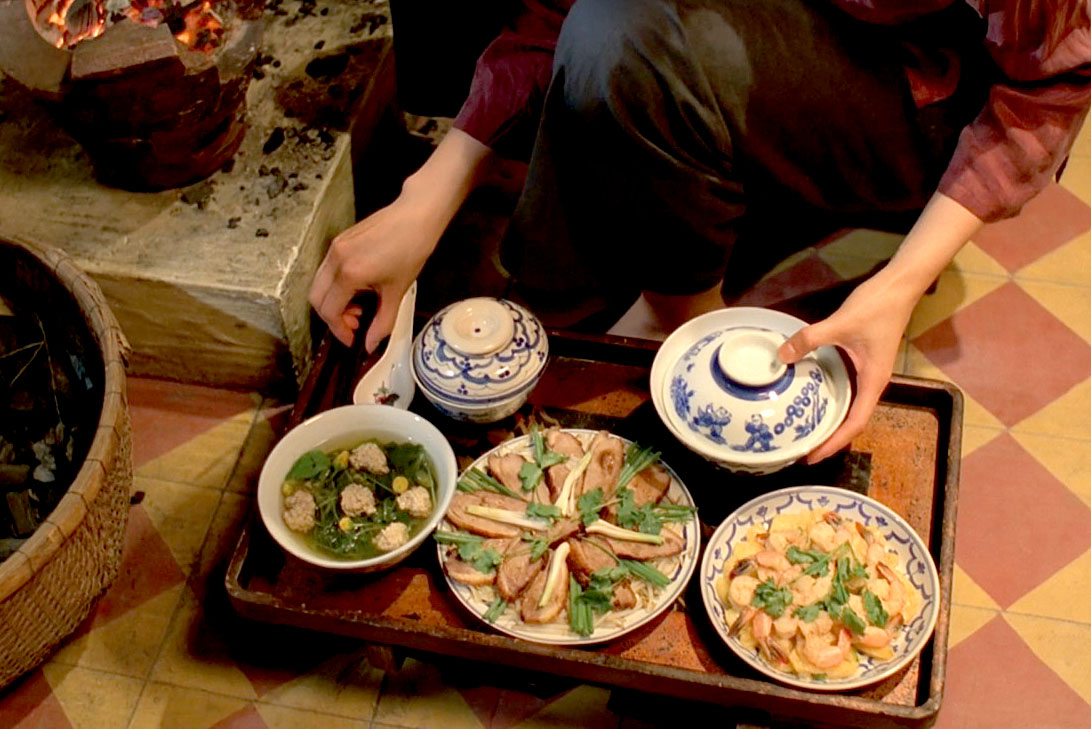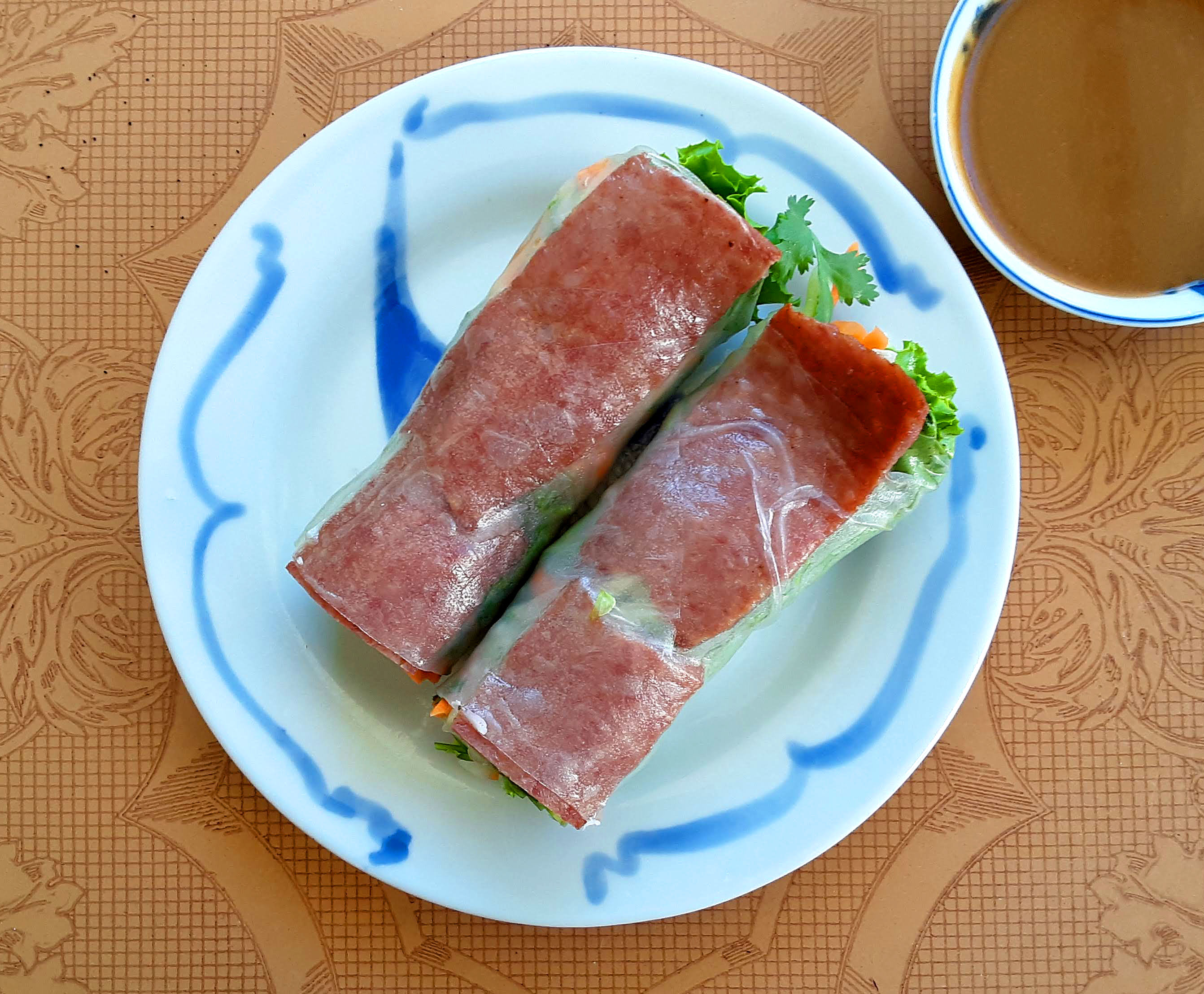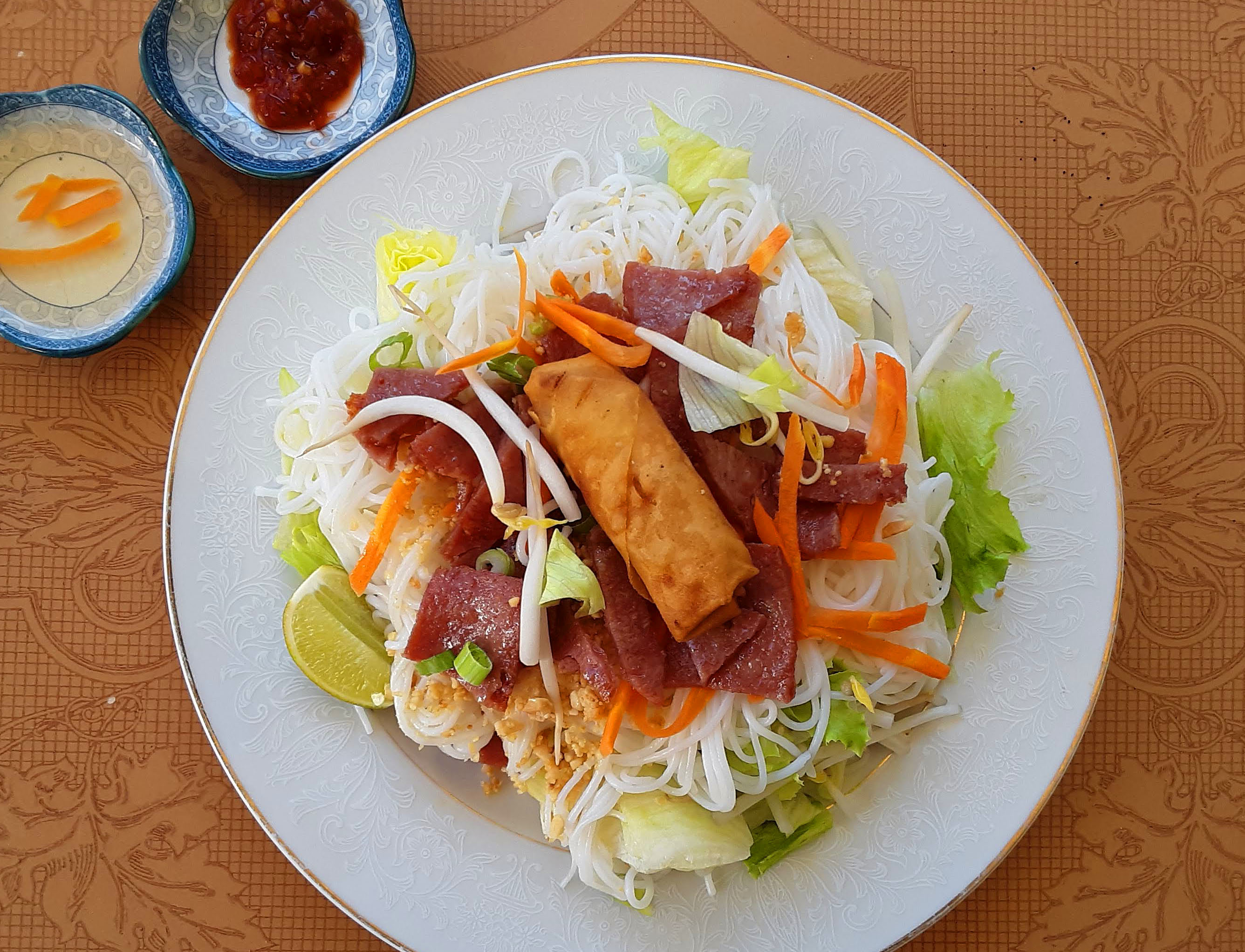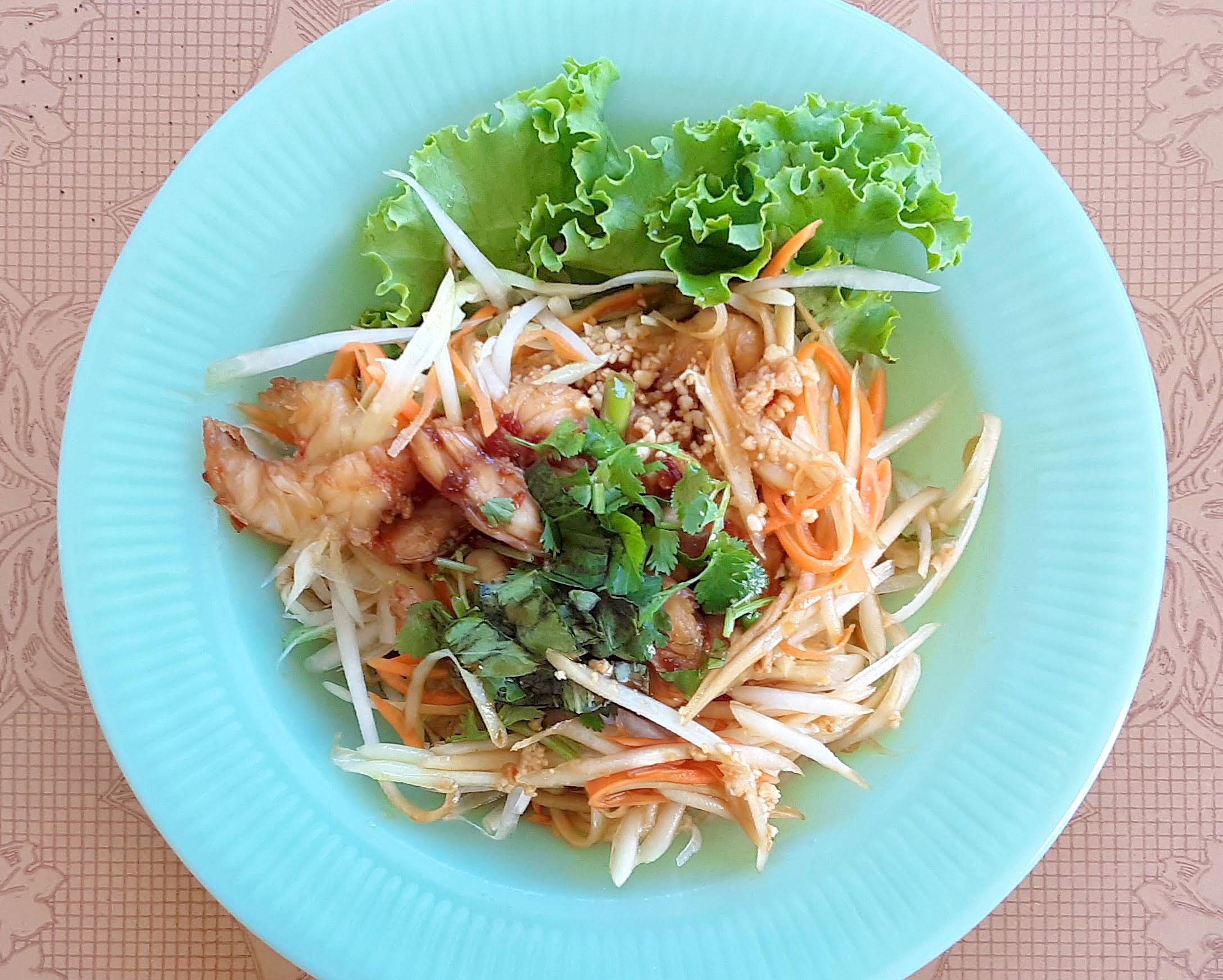The Scent of Green Papaya is a French film set in a nostalgic Vietnam of the past which evokes the poetry of daily life. This movie is a perfect excuse to order a Vietnamese dinner from Xinh Xinh Cafe and stay in for a date night.
Despite the title, The Scent of Green Papaya is not about food. It’s really about rituals, rhythms, the cycle of life, and the interconnectedness of all things.

Photo by First Look International.
Set in 1951, this French/Vietnamese co-production from 1993 begins as a moving painting of a long-lost Saigon viewed with rose-colored glasses. Through a voyeuristic camera, we see a family’s daily rhythms: waking, praying, working, playing, eating, sleeping. We follow a ten-year-old servant girl as she cleans, cooks, serves, and curiously examines the natural word around her. It’s a delicate balance between the roles of men and women, of master and servant, of innocence and malice.
Soon, we’ve settled into the movie’s legato rhythm, slowing down and appreciating the details so meticulously captured for our examination. We feel the heat. We hear the sounds of nature, the crickets, the frogs, the birds, the sounds of the occasional airplane flying overhead. Wait, when was the last time you heard the background sounds of an airplane flying overhead in a movie? Did the director make a mistake and choose the wrong take in the editing room? Aren’t we on a set in a studio in Paris? Was that sound added deliberately? If so, why? Little by little, the importance of these details reveal themselves. Yes, we hear airplanes flying overhead again later in the film when we jump ten years ahead in the story. Yes, the airplane sounds will be different — and that is the point. Things change; things remain the same. People grow — or not.
There is betrayal. There is death. There is love. And there is food.
The Scent of Green Papaya is a complete film, perfect in its conception, perfect in its execution. The film has minimal dialogue, but what’s not said is just as important as what is said. When we do hear dialogue, it’s as if the words were overheard, that we’ve just eavesdropped on a conversation we’re not supposed to hear. Every element in the film has been designed to evoke the right atmosphere, the right rhythm, the right balance for the story being told. The repetitive themes and motifs make subtle connections that add to the texture of the film: the repeated images of bare feet, perhaps reminding us of the journey of life; the breaking of vases, perhaps hinting at the loss of something even more important; the cutting of a green papaya to reveal the seeds, perhaps invoking birth or the start of something new. This is film is visual art, to be cherished and revisited time and again. I’ve seen this film three times, and it stil reveals something new upon every viewing. No surprise then that this debut feature from Tran Anh Hung was nominated for an Oscar.
What about dinner? The movie has plenty of scenes of people eating simple homemade Vietnamese food. They cook over a simple charcoal fire in a simple courtyard kitchen. As a bonus, we also get a few cooking lessons, so you’ll be able to make at least two simple authentic Vietnamese dishes after watching this movie. Are they saying that good food does not need to be complicated? That a slower, simpler life could be just as fulfilling? By the end of the movie, you’ll agree that the answer is a simple “yes.”
If you haven’t tried a green papaya salad yet, you need to watch this movie to see the traditional preparation. Then you can order this dish from no less than four different restaurants in town (Bangkok Thai, Thara Thai, Sticky Rice, and Xinh Xinh Cafe). Because the movie is set in Vietnam, we decided to order from Xinh Xinh Cafe. As usual, we ordered ahead of time, and when the movie was over, we reheated the food, plated the dishes, and indulged.

Photo by Paul Young.
Xinh Xinh Cafe offered four different proteins as add-ons to their green papaya salad, and we chose shrimp ($8). The salad was dressed with a sweet-and-tangy, fish-sauce based dressing, garnished with bean sprouts, carrots, cilantro, and ground peanuts. We added an extra dash of “rooster sauce” to kick up the heat, and the result was a very satisfying appetizer.

Photo by Paul Young.
As a second appetizer, we ordered the pork sausage summer rolls ($6.50). Sometimes called “spring rolls,” this cold appetizer is traditionally wrapped with a thin rice paper and stuffed with shredded daikon, cucumbers, cilantro, and carrots. Of the two types offered at Xinh Xinh, we went with the Vietnamese sausage version which also gave a nice spiciness to each bite. The peanut dipping sauce was perfectly balanced and added depth to this mouth-watering starter.

Photo by Paul Young.
Since we’re going for a Vietnamese dinner, we had to order a bowl of the signature Vietnamese national dish: pho (pronounced “fuh”). This is a big bowl noodle soup traditionally made with a beef broth and rice vermicelli (also sometimes called rice sticks). Xinh Xinh has eight meat versions and one vegetarian option on their menu. I’ve always ordered the Pho Dac Biet combination bowl ($10), so tonight was no different.
A good bowl of pho starts with the broth, and Xinh Xinh’s version was delicate and flavorful. The combo comes with thinly sliced steak, brisket, tendon, tripe, and meatballs, plenty of variety in the beef department. The best part is always the raw veggies that get added at the last minute: bean sprouts, Thai basil leaves, cilantro, and jalapeno peppers. The steaming hot broth softens the veggies just the right amount and also helps cool the broth a little in preparation for your first sip.

Photo by Paul Young.
For a second entree, we ordered the bun nem nuong vermicelli bowl ($8) which was topped with roasted pork sausage and served on a bed of greens with lots of bean sprouts, fresh herbs, roasted peanuts, and a side of lime-infused fish sauce for dressing. A room-temperature dish, this refreshing noodle dish hit the spot.
Xinh Xinh Cafe
114 North Vine St
Urbana
M-Sa 11 a.m. to 8 p.m.
The Scent of Green Papaya is currently streaming on Kanopy (in HD) and Hoopla (in SD). Both platforms are available for free via your local public library (see: info about Kanopy and Hoopla in Champaign or Urbana).
Kanopy is one of those best kept secrets in the streaming world. If you have a library card, you can stream up to 20 free movies a month in Champaign (but only 10 in Urbana). Running low on credits? Get others in your household to sign up for a Kanopy account; how many people in your household already have a library card? There are plenty of free movie streaming sites out there, but almost none are commercial-free, and no other platform has the wide range of interesting titles that you actually want to see. Paid for by your taxes, Kanopy’s constantly rotating roster of movies feature the most diverse collection of indie, foreign, classics, and documentaries available on any streaming platform out there. Can’t afford to subscribe to the Criterion Channel? Kanopy features 50 Criterion titles this month. Don’t want to subscribe to Paramount+ to get access to their classics? Kanopy has 176 older Paramount titles right now. A big fan of the indie studio A24? Kanopy is the go-to platform for A24’s ever-growing archive of cutting edge ground-breaking titles (some say A24 has never made a bad movie). Want to open up your streaming world? This is a good place to start.
If you’ve got other interesting dinner/movie combo suggestions, please comment below or email us. Be creative, but please skip obvious titles like Ratatouille or East Side Sushi. They’re both worth watching, but we know you can do better.








